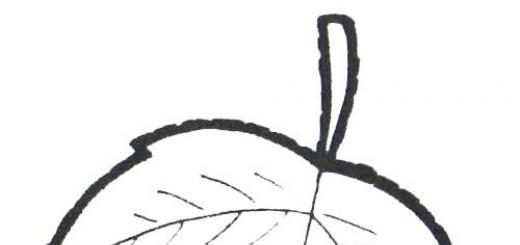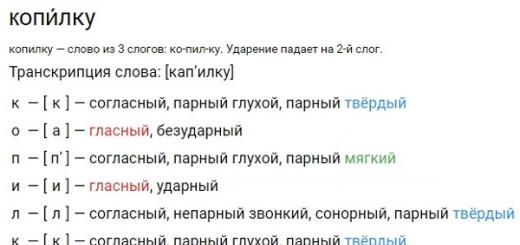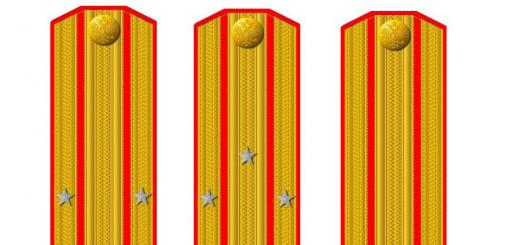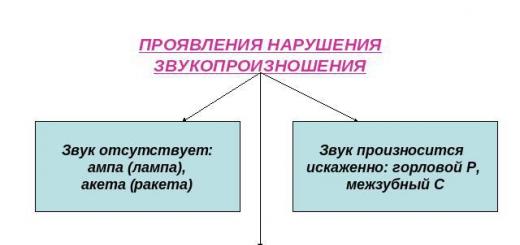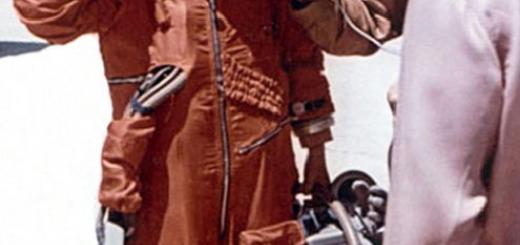Theme M.M. Prishvin "Autumn Morning"
Goals: introduce children to Prishvin’s story “Autumn Morning”;
practice conscious expressive reading skills; develop the ability to work in a group; instill a love for native nature.
Equipment: Computer, projector, presentation for the lesson.
Textbooks “Literary reading” by L.F. Klimanova; portrait of M. Prishvin, his books; tablets with written words; drawings on the theme of autumn; colored sheets for each student; Explanatory dictionary by V.I. Dahl.
During the classes
Organizing time
The bell rang and the lesson began.
Let's hold hands together
And let's smile at each other!
We will work together
We shouldn't be lazy
Speech warm-up
Let's read the sentences in chorus with sequential logical stress.
What a wonderful morning!
What a wonderful morning!
What a wonderful morning!
Let's start our lesson with this major note.
Checking homework
Expressive reading “Tricky mushrooms”
Who wrote? (poet - Valentin Dmitrievich Berestov)
Who prepared the information about mushrooms?
Who wrote these texts, a scientist or a poet?
Where did you look for information about mushrooms?
Setting the topic and lesson goals
Today we will continue our big topic, which is called...” I love Russian nature"
Guess the riddles:
She lit the rowan bonfire.
That's a generous beauty
Smiles playfully
And protects everyone with slanting rain. (autumn)
And who is this girl?
It spreads like a thick fog,
Sings songs with the winds until dawn.
And she’s cold and hungry,
There is melancholy and cold in my soul... Everyone falls asleep, the days fade away. (autumn.)
How do you see autumn in these riddles?(golden; gray, wet, rainy)
What will the lesson be about? (autumn)
What section are we studying now?
I LOVE RUSSIAN NATURE. AUTUMN.
(the topic is written on the cover of a homemade large book)
Today we will learn a lot in class, research, and publish the results of the research in this book.
Do you like autumn?
What do you like about it?
What autumn months do you know? (September October November)
What month is it now? (October.)
October is the middle of autumn. In the old days, this month was called “leaf fall.”
Why? (because withered, yellowed leaves are falling from the trees.)
SIGN - Did you know that if the leaves, falling off, turn upside down, this means a harvest and a warm winter, while the front side up means a cold winter. Check it out!
Working on the lesson topic
How can creative people express their love for autumn? (music, painting, literary work)
You drew pictures about autumn. (in-class exhibition)
Whose paintings do you think are the most successful?
(we put 2 drawings in the book)
But this is how the famous artists I. Levitan and I. Grabar see autumn (painting by I. Levitan “Golden Autumn”, I. Grabar “Rowan and Birch Trees”) - What colors did you and the artists use in your work?
Breathing exercises
There is another story
Wonderful, for you.
It's about how pine needles smell,
Rowan bush and coconut
The morning will be a time of peace...
You breathe in - don't breathe,
Don't wake up the wind in the field,
And breathe out quietly,
The wind blew - O_U_U! The leaves turned yellow and trembled - F_F_F! We flew to the ground - P_P_P! They rustled - Sh_Sh_Sh!
Continuation of work on the topic of the lesson
Let's read the encyclopedia article. What do scientists write about autumn?
Autumn is the time of year following summer and preceding winter. In autumn, the intensity of sunlight is average.
Conversation based on reading
What is the purpose of the text?
What sentences regarding the purpose of the statement were found in it?
What kind of text is this, scientific or literary? (Have we read scientific texts today? - Which one? “About mushrooms”)
What scientific words did you hear? (medium intensity)
Work on M. Prishvin’s story “Autumn Morning”
Game "Collect the name"
Now let’s read another text about autumn. An autumn breeze blew and all the letters fell apart, help me collect the name.
ENESONE RUOT
(2 students at the blackboard, letters on leaves,put in a book)
What do you think will be discussed?
- One student's story about M. Prishvin, showing a portrait.
Mikhail Mikhailovich Prishvin lived a long, eventful life. He came from a poor merchant family that lived in the Oryol province. He received a good natural science education. He worked as an agronomist, for several years he was a rural teacher and librarian. He began writing at the age of 30; this was preceded by a long period of accumulation of impressions, when the writer traveled to the northern regions.(we put the report in the book)
Exhibition of books by M. Prishvin.
Researchgroup work.
Look at the book covers, read the titles. Draw a conclusion about what M. Prishvin wrote about.
Today we will get acquainted with the work of the writer M. Prishvin, a great connoisseur and lover of Russian nature, who devoted all his works to the description of his native nature. His characters love and understand nature. In his stories, not only people, but also animals engage in dialogue. Prishvin was in love with his homeland, with its beauty, with forests and fields, rivers and lakes, with its birds and animals.
And on this shelf are books by Mikhail Prishvin about nature. I advise you to read them.
PHYSMINUTE
We are autumn leaves
We sit on the branches (squat)
The wind blew - they flew (rise, wave their arms)
We flew, we flew
And they sat down quietly on the ground.
The wind came again
And he picked up all the leaves.
Preparatory work for reading
Vocabulary work
Teacher: explain the meaning of the words
- Little by little (slowly a little by little)
- The soul is an incorporeal shell, invisible to the human eye.
- - What is a parachute, a cog, a butterfly?
- - A parachute is a device with a canopy that opens in the air.
- A parachute is a small parachute.
- - How does a parachute fly? (slowly)
- - Screw – a fastening device with a spiral thread.
- - How does the screw rotate? (fast)
- - What is a cog? (small screw)
- - Who is this moth? (small butterfly)
Expressive reading of the story “Autumn Morning” by the teacher. Conversation on first impressions
Did you like it? How did you feel?
What sentences were found in it regarding the purpose of the statement?
What genre does this work belong to? (on the board: signs with the words: fairy tale, poem, story)
Preparatory work
Let's prepare our speech apparatus for reading the story.
Read syllable by syllable, then quickly in whole words:
Waking up, waking up
Pa-ra-shu-tik parachute
Once upon a time they scattered
Cross-flight flights
Re-reading (buzzing) Pre-reading task: find how many times the word “morning” appears in the story.
Gymnastics for gas
Analysis of the work
How many times did the word “morning” appear?
Why do you think?
From what words do we understand that the story is about morning?
Which text have you read now: scientific or literary?
Selective reading
What do you know about Indian summer? (A long period of warm and dry weather at the end of September or the first half of October. In the “Indian summer”, secondary flowering of some plants occurs.)
And what does Prishvin write about Indian summer? (selective reading)
Let's try to depict the movements of the leaves.
(Like a parachute - smoothly, swinging from side to side; like a butterfly - smoothly circling, like a cog - circling quickly).
Which birds will fly away last? (rooks)
What definition does the writer give to an autumn day? Highlight with pencil
What picture do you imagine? (verbal drawing)
What feelings does he have? (selective reading)
How do you understand the last words “and everything will end”?
Group research work (small groups)
Research task: find
Group 1 - comparison
2nd group - epithet (Epithets are adjectives that give expressiveness to speech.)
3rd group - personification (Personification is when an inanimate object is given the properties of living beings.) (put in the book)
...the day opens your eyes... (group 3)
...enjoying a nice warm day... (group 2)
...which leaf flies like a parachute, which one flies like a butterfly, which one flies like a cog... (group 1)
Practicing expressive reading skills. (reserve)
Reading by chain
Creative work(in pairs) Write what autumn is.Autumn is the _________ time of year (we put the best ones in the book)
Homework- read the story to your loved ones and find out their opinion about it; - draw a picture for the story
Reflection - What did you like about the lesson? How are you feeling now? Select a sheet to evaluate your work in class
Red - I’m great!
Yellow - I can do better!
Green - We must try.
Which wonderful day!
Which wonderful day!
How wonderful day!
- Breathing exercises
There is another story
Wonderful, for you.
You breathe in - don't breathe,
Don't wake up the wind in the field,
And breathe out quietly,
The wind blew - O_U_U!
The leaves turned yellow and trembled - F_F_F!
We flew to the ground - P_P_P!
They rustled - Sh_Sh_Sh!
- Pure talk
- Tongue Twisters
I LOVE RUSSIAN NATURE. AUTUMN.
There is in the initial autumn
A short but wonderful time -
The whole day is like crystal,
And the evenings are radiant: (F. Tyutchev)
Lingonberries are ripening,
The days have become colder,
And from the bird's cry
My heart became sadder. (K. Balmont)
Autumn has come
The flowers have dried up,
And they look sad
Bare bushes. (A. Pleshcheev)
The swallows have disappeared
And yesterday dawned
All the rooks were flying
Yes, how the network flashed
Over there over that mountain. (A. Fet)
What did you learn about Prishvin?
- Exhibition of books by M. Prishvin.
Today we will get acquainted with the work of the writer M. Prishvin, a great connoisseur and lover of Russian nature, who devoted all his works to the description of his native nature. His characters love and understand nature. In his stories, not only people, but also animals engage in dialogue. Prishvin was in love with his homeland, with its beauty, with forests and fields, rivers and lakes, with its birds and animals.
- Game "Collect the name"
ENESONE RUOT
Vocabulary work
Teacher: how do you explain the meaning of these words
A parachute is a device with a canopy that opens in the air.
A parachute is a small parachute.
A screw is a fastening device with a spiral thread.
I was especially touched by...
I imagined that...
- Preparatory work
Pa-ra-shu-tik parachute
Once upon a time they scattered
Cross-flight flights
- Re-reading (buzzing)
GYMNASTICS FOR THE EYES
- Analysis of the work
- Selective reading
Reading by chain
Bottom line
Homework
Reflection
What did you like about the lesson? How are you feeling now?
Color the sheet to evaluate your work in class.
Red - I'm great!
Yellow - I can do better!
Green - We must try.
"biography"
Mikhail Mikhailovich Prishvin was born into a poor merchant family living in the Oryol province. He worked as an agronomist, for several years he was a rural teacher and librarian. He began writing at the age of 30 after traveling around the northern regions.
Mikhail Mikhailovich Prishvin was born into a poor merchant family living in the Oryol province. He worked as an agronomist, for several years he was a rural teacher and librarian. He began writing at the age of 30 after traveling around the northern regions.
Mikhail Mikhailovich Prishvin was born into a poor merchant family living in the Oryol province. He worked as an agronomist, for several years he was a rural teacher and librarian. He began writing at the age of 30 after traveling around the northern regions.
Mikhail Mikhailovich Prishvin was born into a poor merchant family living in the Oryol province. He worked as an agronomist, for several years he was a rural teacher and librarian. He began writing at the age of 30 after traveling around the northern regions.
Mikhail Mikhailovich Prishvin was born into a poor merchant family living in the Oryol province. He worked as an agronomist, for several years he was a rural teacher and librarian. He began writing at the age of 30 after traveling around the northern regions.
Mikhail Mikhailovich Prishvin was born into a poor merchant family living in the Oryol province. He worked as an agronomist, for several years he was a rural teacher and librarian. He began writing at the age of 30 after traveling around the northern regions.
Mikhail Mikhailovich Prishvin was born into a poor merchant family living in the Oryol province. He worked as an agronomist, for several years he was a rural teacher and librarian. He began writing at the age of 30 after traveling around the northern regions.
View document contents
"lesson summary"
Theme M.M. Prishvin "Autumn Morning"
Goals: introduce children to Prishvin’s story “Autumn Morning”;
practice conscious expressive reading skills; develop the ability to work in a group; instill a love for native nature.
Equipment: Computer, projector, presentation for the lesson.
Textbooks “Literary reading” by L.F. Klimanova; portrait of M. Prishvin, his books; tablets with written words; drawings on the theme of autumn; colored sheets for each student; Explanatory dictionary by V.I. Dahl.
During the classes
Organizing time
Buzzing Reading
Speech warm-up
Logical stress
Let's read the sentences in chorus with sequential logical stress.
Which wonderful day!
Which wonderful day!
How wonderful day!
Let's start our lesson on this excellent note.
Breathing exercises
There is another story
Wonderful, for you.
You breathe in - don't breathe,
Don't wake up the wind in the field,
And breathe out quietly,
The wind blew - O_U_U!
The leaves turned yellow and trembled - F_F_F!
We flew to the ground - P_P_P!
They rustled - Sh_Sh_Sh!
Pure talk
Tongue Twisters
3. Checking homework
What section are we studying now?
I LOVE RUSSIAN NATURE. AUTUMN.
We read a lot of poems about autumn. Now I will read some of them to you. And you guys should tell the author of the passages.
There is in the initial autumn
A short but wonderful time -
The whole day is like crystal,
And the evenings are radiant: (F. Tyutchev)
Lingonberries are ripening,
The days have become colder,
And from the bird's cry
My heart became sadder. (K. Balmont)
Autumn has come
The flowers have dried up,
And they look sad
Bare bushes. (A. Pleshcheev)
The swallows have disappeared
And yesterday dawned
All the rooks were flying
Yes, how the network flashed
Over there over that mountain. (A. Fet)
4. Setting the topic and lesson goals
5. Work on M. Prishvin’s story “Autumn Morning”
Reading bibliographic data (by students)
Mikhail Mikhailovich Prishvin lived a long, eventful life. He came from a poor merchant family that lived in the Oryol province (region). He received a good natural science education. He worked as an agronomist, for several years he was a rural teacher and librarian. He began writing at the age of 30; this was preceded by a long period of accumulation of impressions, when the writer traveled to the northern regions.
What did you learn about Prishvin?
Exhibition of books by M. Prishvin.
Look at the book covers, read the titles. Draw a conclusion about what M. Prishvin wrote about.
Today we will get acquainted with the work of the writer M. Prishvin, a great connoisseur and lover of Russian nature, who devoted all his works to the description of his native nature. His characters love and understand nature. In his stories, not only people, but also animals engage in dialogue. Prishvin was in love with his homeland, with its beauty, with forests and fields, rivers and lakes, with its birds and animals.
And on this shelf are books by Mikhail Prishvin about nature. I advise you to read them.
Game "Collect the name"
An autumn breeze blew and all the letters fell apart, help me collect the name.
ENESONE RUOT
(2 students at the board, letters on leaves)
What do you think will be discussed?
Preparatory work for reading
Vocabulary work
Teacher: How do you explain the meaning of these words?Little by little (slowly a little by little)
The soul is an incorporeal shell, invisible to the human eye.
What is a parachute, a cog, a butterfly?
A parachute is a device with a canopy that opens in the air.
A parachute is a small parachute.
How does a parachute fly? (slowly)
A screw is a fastening device with a spiral thread.
How does the screw rotate? (fast)
What is a cog? (small screw)
Who is the moth? (small butterfly)
Expressive reading of the story “Autumn Morning” by the teacher. Conversation on first impressions
Did you like it? How did you feel?
I was especially touched by...
I imagined that...
Preparatory work
Let's prepare our speech apparatus for reading the story.
Read syllable by syllable, then quickly in whole words:
Waking up, waking up
Pa-ra-shu-tik parachute
Once upon a time they scattered
Cross-flight flights
Reread (buzzing)
Pre-reading task: While reading the text, pay attention to what unites M. Prishvin’s story with the poems of Russian poets?
GYMNASTICS FOR THE EYES
Analysis of the work
Who is ready to answer the question: What unites M. Prishvin’s story with the poems of Russian poets?
Determine the main idea of the story (That you need to see beauty in everything).
Selective reading
What do you know about Indian summer? (A long period of warm and dry weather at the end of September or the first half of October. In the “Indian summer”, secondary flowering of some plants occurs.)
And what does Prishvin write about Indian summer? (flying cobweb)
(Like a parachute - smoothly, swaying from side to side; like a butterfly - circling smoothly, like a cog - circling quickly).
Which birds will fly away last? (rooks)
How does the writer describe an autumn day? (Opens eyes, wakes up)
What picture do you imagine? (verbal drawing)
Practicing expressive reading skills. (reserve)
Reading by chain
Bottom line
What did he write about in his stories?
Homework
P. 78, draw an illustration for the story in your notebooks
Reflection - What did you like about the lesson? How are you feeling now? Color the sheet to evaluate your work in class.
Red - I’m great!
Yellow - I can do better!
Green - We must try.
View document contents
"leaves"








 Breathing exercises
Breathing exercises
- The wind blew - O_U_U!
- The leaves turned yellow and trembled - F_F_F!
- We flew to the ground - P_P_P!
- They rustled - Sh_Sh_Sh!

Su-su-su - quiet in the forest in autumn
Tsk-tsy-tsy-the chicks want to eat
Mushrooms grow in the forest

Ra-ra-ra - the mouse has a hole
I'm chewing, chewing, chewing, knitting a blouse
Tsa-sa-cha - the rook's chick grew up

I met a hedgehog in a thicket:
- How's the weather, hedgehog?
- Fresh.
And we went home, trembling,
Hunching, cowering, two hedgehogs.

Over the ditches, over the hump O glasses
We went into the forest to pick mushrooms.

I love Russian nature
Autumn

Collect a title
ENESONE RUOT


Mikhail Mikhailovich Prishvin




Vocabulary work
Little by little
Parachute
Butterfly
cog

- I was especially touched...
- I imagined that...

It's waking up
Pa-ra-shu-tik parachute
Once upon a time they scattered
Cross-flight flights

- Red - I’m great!
- Yellow - I can do better!
- Green - We must try

Theme M.M. Prishvin "Autumn Morning"
Goals
: introduce children to Prishvin’s story “Autumn Morning”; practice conscious expressive reading skills; develop the ability to work in a group; instill a love for native nature.
Planned results
personal:
development of educational and cognitive interest in new educational material and methods of solving a particular problem; the formation of a sense of beauty and aesthetic feelings based on a work of art, understanding the feelings of the author and empathy for him;
regulatory:
accept and maintain the learning task, follow the rules of dialogue, perform learning actions in a loud and mental form;
educational:
read expressively, build a short monologue based on a scientific text; predict by deciphering a sentence, “turn on” the imagination, construct a speech utterance orally, analyze objects and, based on it, present a holistic picture.
Equipment : Computer, projector, presentation for the lesson. Textbook “Literary Reading” by L.F. Klimanova; portrait of M. Prishvin, his books; tablets with written words; colored sheets for each student
Organizing timeGeneral readiness of children for the lesson.
Children's attention span.
Checking readiness.
Smile at each other. Give me your attentive eyes.Speech warm-up
Let's read the sentences in chorus with sequential logical stress.
Which
wonderful morning!
Whichwonderful
morning!
How wonderfulmorning
!
Self-monitoring of readiness.
Reaction to the teacher, attention.
Expressive reading
Istage
Motivation for activity: creating a situation of success
1.Checking homework. Message from additional sources about mushrooms.
Reading a poem by V. Berestov
2.Updating knowledge, emergence of the lesson topic.
View the presentation “Golden Autumn”
Conversation about autumn based on personal observations of children
3. Anticipation of reading.
Prediction based on sentence expansion into text.
Word drawing.
4. The emergence of lesson goals.
Who prepared the information about mushrooms?
-Who wrote these texts, a scientist or a poet?
-Where did you look for information about mushrooms?
Read “Cunning Mushrooms” expressively
-Who wrote?
Guess the riddle:
- She lit the rowan bonfire.
That generous beauty smiles playfully
And protects everyone with slanting rain.
-
Autumn never repeats itself - every year it brings us something new, unknown, delighting and delighting people with a wonderful sight. Many writers, artists, musicians admired autumn, and each showed it in their own way in their works.
(slide show. Paintings by Russian artists V. Polenov, I. Levitan, I. Grabar)
- What kind of autumn did you see on the way to school? What did you admire? What surprised you?
What do you think will be discussed in class today?
There is an offer on the screen. Read it carefully and imagine the picture on your mental screen.
Here you stand on the shore, alone, put your palm to your heart, and with your soul, along with the birds and leaves, you fly somewhere.
Use your words to paint the picture you have imagined.
What else did you see?
When does this happen?Breathing exercises
There is another story
Wonderful, for you.
It's about how pine needles smell,
Rowan bush and coconut
The morning will be a time of peace...
You breathe in - don't breathe,
Don't wake up the wind in the field,
And breathe out quietly,
The wind blew - O_U_U! The leaves turned yellow and trembled - F_F_F! We flew to the ground - P_P_P! They rustled - Sh_Sh_Sh!.
Today we will get acquainted with the work of the writer M. Prishvin, a great connoisseur and lover of Russian nature, who devoted all his works to the description of his native nature. His characters love and understand nature. In his stories, not only people, but also animals engage in dialogue. Prishvin was in love with his homeland, with its beauty, with forests and fields, rivers and lakes, with its birds and animals.
We will read the story “Autumn Morning” and compare our impressions with those of the author. Let's try to understand what M.M. saw and felt. Prishvin.
A story about mushrooms with a demonstration of drawings of mushrooms.
Accurate information about mushrooms can be found in the encyclopedia or in reference books for mushroom pickers. These are scientific texts.
Expressive reading.
Listening, solving a riddle.
It's autumn.
Looking at paintings
Very beautiful birch trees. They dressed in golden outfits and the surroundings became lighter.
- I saw birds flying away. I felt sad.
- In the morning, when I went to school, it was so quiet that I could hear the rustling of leaves.
The wind blew and leaves rained down in colorful rain. That's very beautiful.
Probably about autumn.
A man stands alone on the river bank. He's worried about something and puts his hand to his heart.
In the distance, a flock of birds flies south.
Leaves fall from the trees onto the shore and into the water.
This was, of course, in the fall.
Acceptance of lesson goals, readiness to read and discuss the text.
IIstage
Educational-cognitive-
naya activity.
1. Primary perception of the text.
2. Checking the initial perception of the text
Educational dialogue
Formulation of the problem
3. Motivation for rereading and analyzing the work
Dialogue with text
4. Conversation on the content as a whole.
Reading by the teacher of M. Prishvin’s work “Autumn Morning”.
Have you ever watched autumn leaves fall from trees?
Did you like the work? How did you feel?
Remember our word picture before reading the text. What haven't we been able to pinpoint? If you find it difficult to answer, look at the title.
Read syllable by syllable, then quickly in whole words:
It's waking up
Pa-ra-shu-tik parachute
Once upon a time they scattered
Cross-flight flights
Now slowly and thoughtfully read the story to yourself. Find how many times the word “morning” appears in the text?
- How many times did the word “morning” appear?
- Why do you think?
- From what words do we understand that the story is about the morning?
- Which text have you just read: scientific or literary?
What signs of autumn is the author talking about?
What definition does the writer give to an autumn day?
What feelings does he have?
Which birds will fly away last?
- How do you understand the last words “and everything will end”?
PHYSMINUTE
We are autumn leaves
We sit on the branches (squat)
The wind blew - they flew (rise, wave their arms)
We flew, we flew
And they sat down quietly on the ground.
The wind came again
And he picked up all the leaves.
Watching, listening, understanding.
In calm weather, leaves fall slowly, smoothly and infrequently. They seem to hover in the air.
I think they look like butterflies.
And I saw them turning like a cog.
They also look like a flock of small birds.
I liked the product. It's interesting how the leaves fall.
The duration of action was not determined precisely. We said it was in the fall. Prishvin talks about an autumn morning.
Reading in chorus quietly, loudly
Independent reading to yourself. Searching for an answer to the question posed.
The word “morning” does not appear in the text. It's only in the title.
Little by little the day opens your eyes.
Showing attention to the opinions of comrades, the desire to find and “unravel” the author’s clues in the text.
The ability to answer in detail, using elements of retelling and expressive reading. Ability to determine the topic of a text.
IIIstage
Solving an educational and practical problem
1.Creative task
2. Conceptual conversation based on the text.
Continued acquaintance with the writer.
Expressive reading of a work
(reserve) chain
Group research work (small groups)
Research task: find
Group 1 - comparison
2nd group - epithet (Epithets are adjectives that give expressiveness to speech.)
3rd group - personification (Personification is when an inanimate object is given the properties of living beings.)
What autumn morning did the author help you see?
What mood was M.M. Prishvina that morning?
Continue the sentence: “Autumn is ……… time”
Man is a creation of nature. Love for nature is a natural feeling of a normal person. But there are people with some special love for nature: timid birds are not afraid of them; plants and animals show them their secrets. It’s as if nature itself is revealing its secrets to them. M.M. was such an amazing person. Prishvin. His soul lives in stories. Reading Prishvin’s books, it’s as if we are talking with him.
Portrait display.
Exhibition of books by M. Prishvin.
… which leaf flies like a parachute, which one flies like a butterfly, which one flies like a cog... (group 1)
…enjoying a nice warm day... (group 2)
…the day opens your eyes... (group 3)
Participation in a group discussion. The ability to correct and change your point of view.
Independently highlighting the main idea of the text. The ability to characterize the writer’s personality based on what he has read (what is he like? What attracts him in the world, what is unique about his view of the world? etc.).
Correcting your initial ideas about the writer.
One student's story about M. Prishvin
Mikhail Mikhailovich Prishvin lived a long, eventful life. He came from a poor merchant family that lived in the Oryol province. He received a good natural science education. He worked as an agronomist, for several years he was a rural teacher and librarian. He began writing at the age of 30; this was preceded by a long period of accumulation of impressions, when the writer traveled to the northern regions.
Stage IV
Reflection stage. Performance evaluation
The teacher is asked questions:
What discovery did you make in class today?
What could you tell your parents at home after our lesson?
Assessment and reflection of one’s own and collective activities
Homework
Creative task (the child acts as the author).
Draw a picture for the story.
Write your own story on the theme “Morning in the autumn forest.”
Drawing a landscape step by step
Master class on drawing. Landscape "Foggy morning"
Annenkova Elena Nikolaevna, fine arts teacher at the Glebovskaya Secondary School, Fatezhsky district, Kursk region.Description of material: I offer you a master class on depicting in watercolor such a natural phenomenon as fog. This material is aimed at students of primary and secondary school age. It will be useful for fine arts teachers, primary school teachers who independently organize fine arts lessons.
Purpose: interior decoration.
Target: depiction on a plane of such a natural phenomenon as fog, using specific pictorial techniques.
Tasks:
1. consolidate skills in using the painting technique “wet”, “dry brush”,
2. develop the ability to perceive the beauty of nature, convey the mood in the landscape,
3. develop creativity, aesthetic taste,
4. cultivate love for native nature.
Materials and accessories required for work:
- container with water,
- watercolor paints,
- artistic watercolor paper,
- squirrel or synthetic brushes, one bristle brush,
- sponge,
- frame.

Watercolor is painting with transparent paints diluted in water. It is very important to keep the paint layer thin and transparent.
In watercolor painting, the application of a paint layer on a wet basis (on the wet surface of the base) is often used. This method of working allows you to obtain light, transparent color shades with soft transitions. The raw method of working is especially successfully used in landscape painting, when it is necessary to convey some atmospheric phenomena - the state of a cloudy day, a foggy morning, evening twilight.
Paints applied wet blur and may go beyond the boundaries of the intended design. Then the excess paint layer is carefully selected with a wrung out clean brush.
Let's try to write a foggy morning. The box of artistic watercolor paints always indicates the composition of the set with the name of the paints. This will make it easy for beginners to find the colors they need to mix.
Lightly moisten a sheet of watercolor paper with water. You can do this with a wide brush, but it is better to use a sponge. The paper should be evenly saturated and not contain excess water.

We mix emerald and dark violet on a palette (on glass with white paper placed under it), and use long, wide horizontal strokes to depict the wet field. Add a little natural sienna to this color and make a few horizontal strokes on the field. If you have experience working with watercolors, you can mix paints directly on the plane of the paper.

We strongly dilute ultramarine with water and paint the upper part of the landscape - the sky. Add a little light purple, blue, pinkish (highly diluted red kraplak). The colors should be completely transparent.

While the top part of the work is not dry, we write the margins in the distance. To do this, mix dark green with sienna and apply frequent vertical strokes in the middle of the upper part of the work, which should spread beautifully on the damp surface of the paper.


We depict isolated trees in the distance. To do this, put a mixture of emerald with ultramarine or dark violet on the brush, add a little burnt umber and make short vertical strokes, grouping them.



On a light strip of fog we depict haystacks in the distance, adding a little blue-green to the natural sienna.


In the foreground we will also depict a haystack, but for it we will mix emerald color with dark violet and burnt umber.

When the landscape dries slightly, we will emphasize the tops of the haystacks in the background with natural sienna, and add volume to the haystack in the foreground. To do this, take a little dark purple paint onto a dry bristle brush and make a few strokes on one side of the haystack.


Mix emerald green with dark purple, put paint on a dry brush and paint the lying grasses in the foreground.

All that remains is to insert our landscape into the frame.

Thank you for watching!
